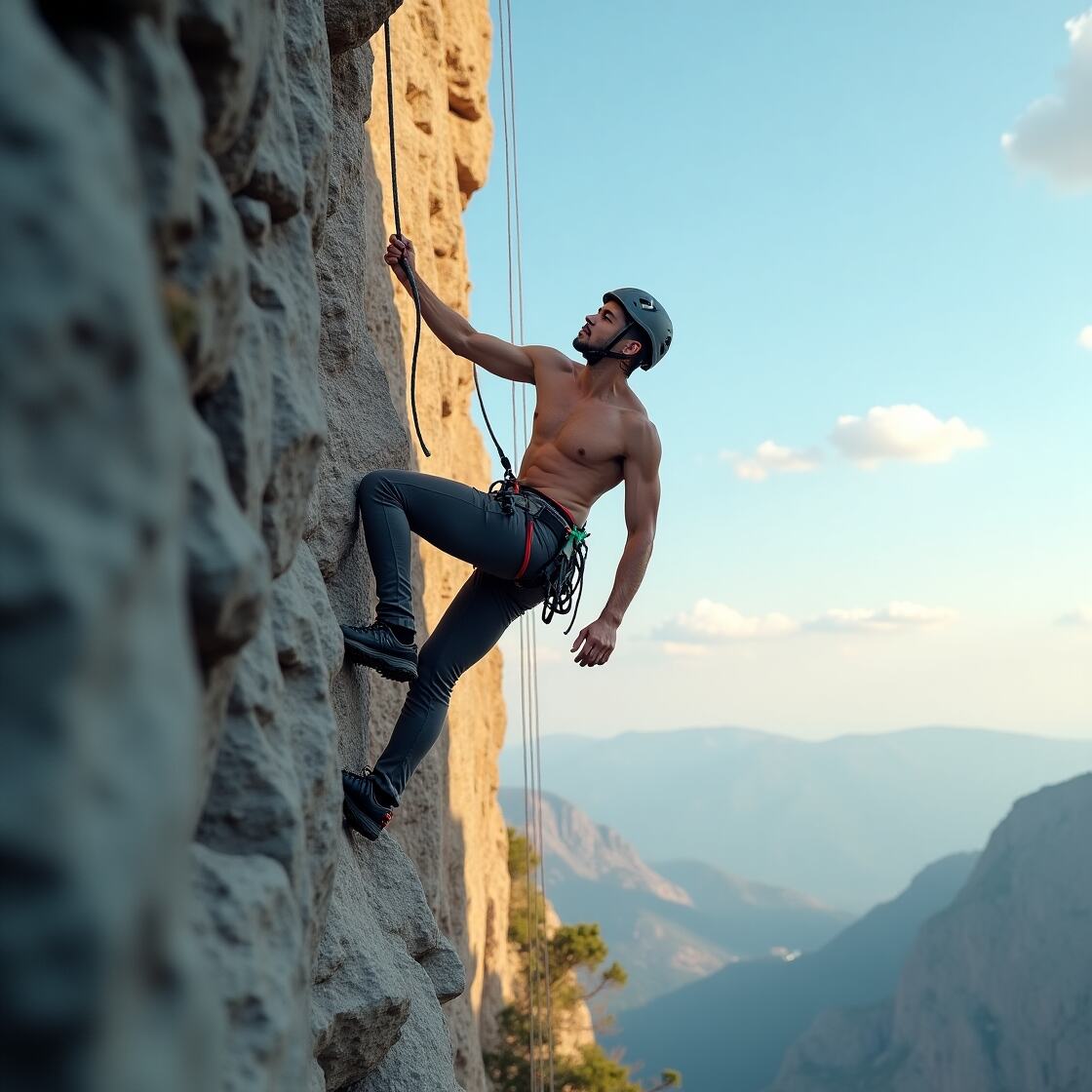Discover how to train for multi-pitch rock climbing with our comprehensive guide. Learn key exercises, mental strategies, and gear tips to conquer long routes. Perfect for beginners and intermediates aiming to boost endurance and skills for epic climbs. Start your training today!
Multi-pitch rock climbing is an exhilarating pursuit that takes you high above the ground, scaling cliffs and mountains in a series of rope-length segments called pitches. Unlike single-pitch climbing, where you return to the ground after one ascent, multi-pitch routes demand endurance, technical expertise, and mental fortitude to tackle routes that can span hundreds of meters. According to a 2023 survey by the American Alpine Club, 68% of climbers aspire to try multi-pitch climbing, yet only 25% feel adequately prepared due to its physical and technical demands. This guide provides a fresh, actionable roadmap to train for multi-pitch rock climbing, covering physical conditioning, skill development, mental preparation, and gear essentials to help you conquer those towering routes with confidence.
What is Multi-Pitch Rock Climbing?
Multi-pitch rock climbing involves ascending routes longer than a single rope length (typically 50-70 meters), requiring climbers to break the climb into multiple pitches. Each pitch ends at a belay station, where climbers secure themselves to anchors, switch roles, and continue upward. A 2024 report by Climbing Magazine notes that multi-pitch routes make up 30% of the most popular climbs in the U.S., with destinations like Yosemite and Red Rocks leading the trend. These routes can involve traditional (trad) climbing, where climbers place their own protection, or sport climbing, with pre-placed bolts. The extended time on the wall, exposure to elements, and complex descents make multi-pitch climbing a thrilling but demanding adventure.
Key Features of Multi-Pitch Climbing
- Multiple Pitches: Routes are divided into segments, each requiring a belay station.
- Teamwork: Typically done in pairs, with climbers alternating as leader and follower.
- Descent Challenges: Rappelling or walk-offs are often required, adding complexity.
- Exposure: Long routes mean prolonged exposure to heights, weather, and fatigue.
Why Train for Multi-Pitch Rock Climbing?
Training for multi-pitch climbing is essential to handle its unique challenges. A 2022 study by the International Journal of Sports Medicine found that climbers who trained specifically for endurance and grip strength reduced their risk of fatigue-related accidents by 40%. Proper preparation enhances safety, boosts performance, and ensures you enjoy the stunning views and sense of accomplishment that come with summiting a multi-pitch route.
Physical Training for Multi-Pitch Climbing
Physical fitness is the foundation of multi-pitch success. Long routes require endurance, strength, and balance to navigate varied terrain like slabs, cracks, and overhangs. Below are key training strategies to build the necessary physical prowess.
1. Build Climbing-Specific Strength
Multi-pitch climbing demands upper body and grip strength for sustained pulling and holding. Incorporate these exercises into your routine 3-4 times per week:
- Pull-Ups: Aim for 3 sets of 8-12 reps to strengthen lats and biceps. Add weight vests for advanced climbers.
- Hangboard Training: Perform 10-second hangs on medium holds for 6 reps, resting 3 minutes between sets, to boost finger strength. A 2023 study by the Journal of Strength and Conditioning Research found that 8 weeks of hangboard training increased grip strength by 15%.
- Core Workouts: Planks (3 sets of 60 seconds) and leg raises (3 sets of 15 reps) stabilize your core for balance on steep routes.
2. Enhance Endurance
Endurance is critical for multi-pitch routes that can last 4-12 hours. A 2024 survey by Outdoor Research reported that 72% of multi-pitch climbers cited endurance as their biggest training challenge. Try these:
- Cardiovascular Training: Run, cycle, or swim for 30-45 minutes, 3 times weekly, to build aerobic capacity.
- Climbing Intervals: At the gym, climb moderate routes (5.7-5.9) for 20 minutes without rest, simulating multi-pitch demands. Rest 5 minutes, then repeat for 3 rounds.
- Long Sessions: Spend 2-3 hours on single-pitch routes outdoors to mimic the sustained effort of multi-pitch days.
3. Improve Flexibility and Balance
Flexibility aids in reaching distant holds, while balance prevents falls on slabs. Incorporate yoga (e.g., Warrior III or Tree Pose) for 20 minutes, 2-3 times weekly, to enhance both. A 2023 study by the Journal of Sports Science found that climbers who practiced yoga reduced injury rates by 22%.
Technical Skills Training
Multi-pitch climbing requires proficiency in advanced climbing techniques. Practice these skills to ensure smooth and safe ascents.
1. Master Anchor Building
Secure anchors are critical at belay stations. Practice building anchors with slings, cordelettes, and locking carabiners on single-pitch routes. Use the SERENE principle (Strong, Equalized, Redundant, Efficient, No Extension) to ensure safety. Take a course from providers like the American Mountain Guides Association, which trained 1,200 climbers in anchor skills in 2024.
2. Refine Rope Management
Poor rope management can lead to tangles, slowing progress. Practice flaking and stacking ropes neatly at the gym or crag. Use lap coils or a sling to manage excess rope during belays. According to a 2024 Climbing Magazine poll, 65% of multi-pitch accidents involve rope-related errors, underscoring the need for practice.
3. Learn Rappelling and Self-Rescue
Rappelling is often required for descents. Practice using an ATC with a prusik backup and tying stopper knots to prevent slips. Learn self-rescue techniques, such as escaping the belay or assisting a stuck partner, through courses or mentorship. A 2023 report by the American Alpine Club noted that 30% of climbing rescues involved rappelling errors.
4. Practice Communication
Clear communication prevents confusion on windy or crowded routes. Use concise commands like “On belay!” or “Take!” and practice with your partner on single-pitch routes. For long pitches, consider walkie-talkies, as recommended by 80% of guides surveyed by REI Co-op in 2024.
Mental Preparation for Multi-Pitch Climbing
Mental resilience is as crucial as physical strength. Multi-pitch routes involve exposure to heights, long hours, and unexpected challenges like weather changes. Here’s how to prepare:
- Visualize Success: Spend 5 minutes before training visualizing each pitch, anchor setup, and descent. A 2024 study in the Journal of Sports Psychology found visualization improved climbers’ focus by 18%.
- Manage Fear: Practice breathing exercises (e.g., 4-7-8 technique) to stay calm during exposure. Start with shorter multi-pitch routes (2-3 pitches) to build confidence.
- Build Decision-Making Skills: Simulate scenarios like route-finding errors in the gym to practice problem-solving under stress.
Gear Essentials for Training and Climbing
Training with the right gear prepares you for multi-pitch conditions. Here’s what you need:
- Climbing Rope: A 60-70m dynamic rope (e.g., Mammut 9.5mm Crag Dry) for versatility.
- Protection: Quickdraws for sport routes or a rack of cams and nuts for trad routes.
- Belay Device: An ATC Guide or Petzl Grigri for belaying from above.
- Anchor Gear: Cordelettes, slings, and 6+ locking carabiners for secure anchors.
- Helmet and Harness: Essential for safety (e.g., Black Diamond Vision Helmet).
- Backpack: A 15-25L pack (e.g., Patagonia Ascent 20L) for water, snacks, and layers.
- Training Tools: A hangboard (e.g., Beastmaker 1000) and campus board for home workouts.
Practice using gear in the gym to simulate multi-pitch conditions. A 2024 GearJunkie survey found that 55% of climbers prioritize lightweight gear for multi-pitch routes to reduce fatigue.
Sample 12-Week Training Plan
This 12-week plan builds strength, endurance, and skills for a multi-pitch climb:
- Weeks 1-4: Foundation
- Gym climbing: 3 sessions/week (focus on 5.7-5.9 routes).
- Strength: Pull-ups, planks, hangboard (2 sessions/week).
- Cardio: 30-minute runs or cycling (2 sessions/week).
- Skills: Practice belaying and rope management.
- Weeks 5-8: Endurance and Technique
- Gym climbing: 3 sessions/week (20-minute endurance circuits).
- Strength: Add weight to pull-ups, increase hangboard intensity.
- Cardio: 45-minute sessions (3 times/week).
- Skills: Take an anchor-building course; practice rappelling.
- Weeks 9-12: Multi-Pitch Simulation
- Outdoor climbing: 2-3 pitch routes (1-2 days/week).
- Strength: Maintain with 2 sessions/week.
- Cardio: Long hikes or climbs (1-2 hours, 2 times/week).
- Skills: Practice self-rescue and communication with your partner.
Best Destinations to Test Your Training
Apply your training at these world-class multi-pitch locations:
- Yosemite National Park, CA: Try Nutcracker (5.8, 5 pitches) for moderate trad climbing.
- Red Rocks, NV: Levitation 29 (5.11c, 10 pitches) offers bolted sport routes.
- Zion National Park, UT: Monkeyfinger (5.12b/5.10+, 9 pitches) for adventurous climbers.
- Eldorado Canyon, CO: Rewritten (5.7, 6 pitches) is beginner-friendly.
Common Mistakes to Avoid
- Overtraining: Rest 1-2 days between climbing sessions to prevent injuries.
- Poor Route Planning: Study topos and guidebooks to avoid getting off-route.
- Neglecting Communication: Practice commands to ensure clarity.
- Underestimating Descents: Plan rappels or walk-offs in advance.
Ready to conquer your first multi-pitch climb? Start your training today with our 12-week plan and test your skills on a short route. Join a climbing gym, take a course, or connect with a mentor to refine your techniques. Share your training journey or favorite routes in the comments below, and let’s inspire each other to reach new heights!

